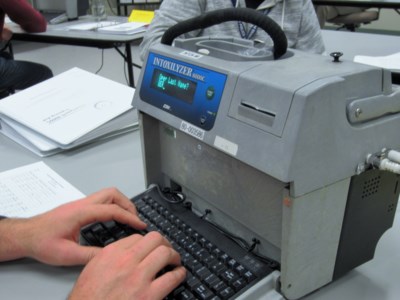One hour of drinking might not seem like a lot for many in Northern Ontario, but testing that occurred this week shows how quickly a person can become a menace behind the wheel.
Members of the Timmins Police Service have been receiving training all week on the 'Intoxilyzer 8000C', a device that is being called cutting-edge technology used in the war on drinking and driving.
A group of volunteer subjects were invited to the TPS headquarters for one hour of steady consumption, of wine, liquor, and beer, before being herded into the training room to give officers a chance to perform breath tests on tipsy, albeit agreeable individuals.
"We were trying to get samples from people in a controlled environment to the instrument. It gives us an opportunity to see what readings we get, again in a controlled environment. It's a little bit harder to train if you're out on the street, where you have other things to worry about," said Constable Jeff DelGuidice.
"Unfortunately, we have to have these courses, because we do have impaired drivers. Hopefully one day, this course won't even operate because there won't be any impaired driving. But for now we have to learn how to use these machines," he said.
TPS Corporate Communications Coordinator Marc Depatie said being front of an Intoxilyzer is 'the last place you want to be', and that any mature individual should never have to.
"When they know that they'll be celebrating and consuming alcohol in social settings, they have to know that they have to get home somehow, and to plan now to avoid being brought in front of an Intoxilyzer while under arrest for impaired driving. It's entirely avoidable," he said.
In 2014 the TPS handed out 46 impaired driving charges. This number dropped in 2015, with a total of 36 charges handed out. There were officially 23 motor vehicle collisions directly related to drunk driving from January 2014 to December 2015.
This means that the message isn't getting through to everyone.
Depatie said that when it comes to an individual determining whether or not they should drive after drinking, they are their own worst enemy.
"They are the least qualified person to make that determination. Once you've had anything to drink, your decision making is thrown off-kilter. We make poor decisions when we're under the influence of alcohol. Its a common side-effect to alcohol, to be a little more care-free with the rules, a little more willing to participate in dangerous, if not neglectful behaviours" he said.
Not all of the officers who trained this week were locals, some are in town for the training from other communities. The Intoxilyzer certification only lasts a year, so a refresher course will go on year-round.
 Hopefully you never meet the Intoxilyzer 8000C. Andrew Autio for TimminsToday
Hopefully you never meet the Intoxilyzer 8000C. Andrew Autio for TimminsToday "We're happy to participate with our neighbouring police forces. This makes for a better trained police force in the Timmins area, and a police force that is better able to respond to the demands of modern policing," said Depatie.
All officers who wish to operate an Intoxilyzer are required to be trained by the province through the Centre of Forensic Sciences.
DelGuidice said none of the samples provided by the volunteers were particularly eye-popping, although it could be attributed to inexperience.
"We're just learning this instrument, so for us some of these readings we think are normal, where other people may think these readings are off the charts," he said.
Some of the subjects did show signs of intoxication. There were of course many variables including gender, body weight, rest, and drinking experience. During the closely monitored one-hour binge, some of the subjects consumed more than others, or consumed higher potency beverages. The subjects averaged 3-5 drinks consumed. Tests later revealed that the number of subjects who were fit to operate a motor vehicle was zero.
